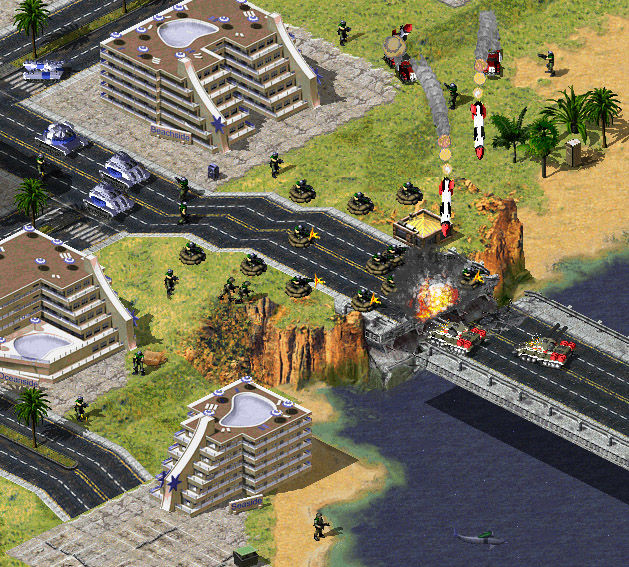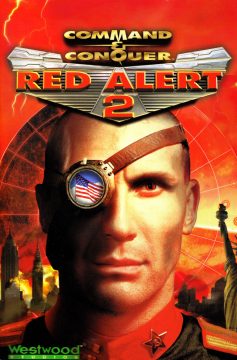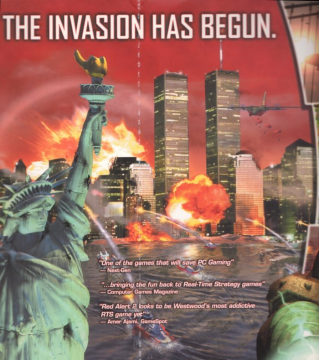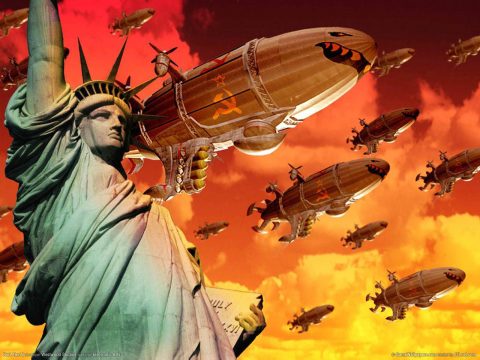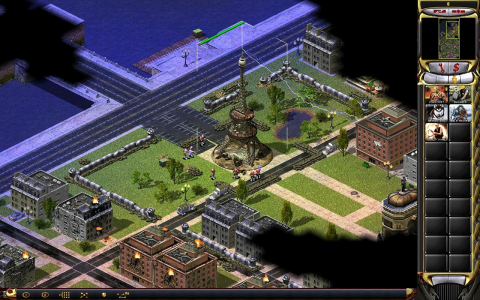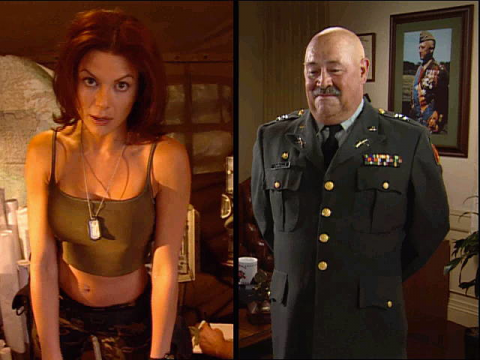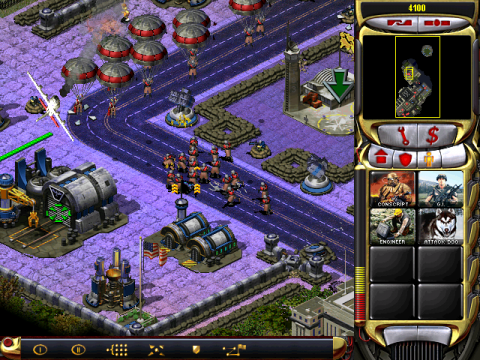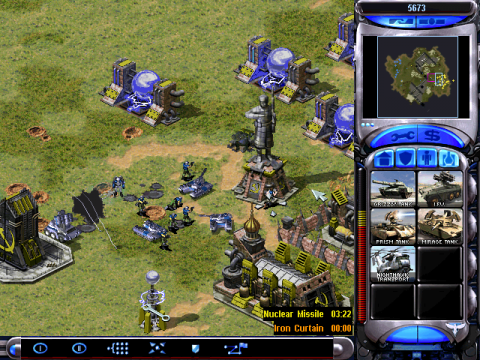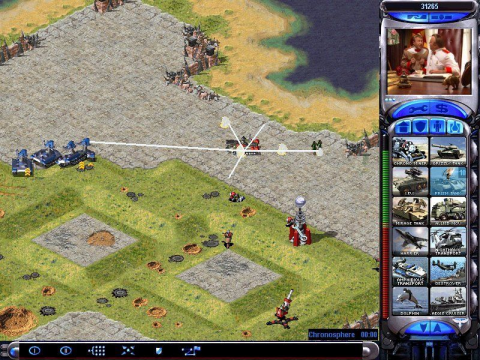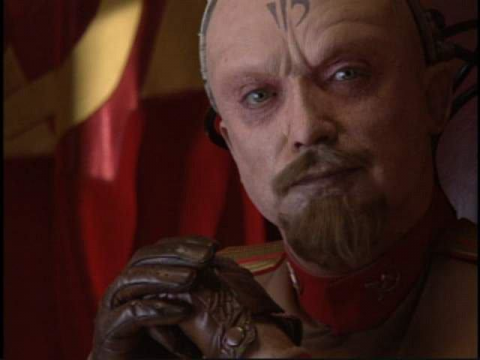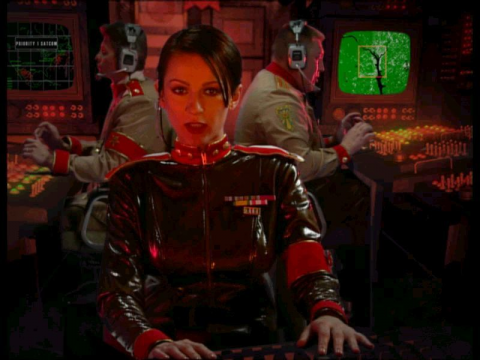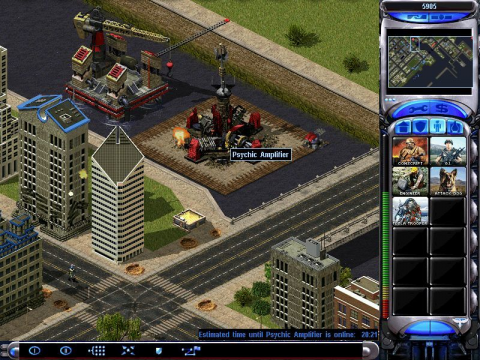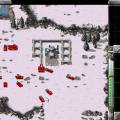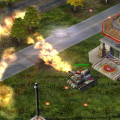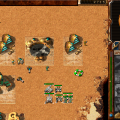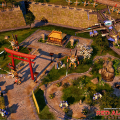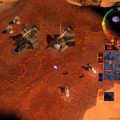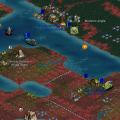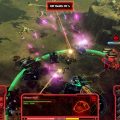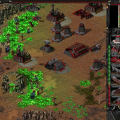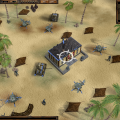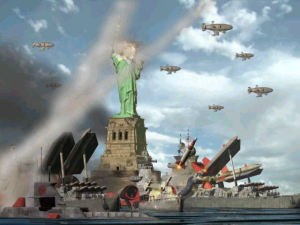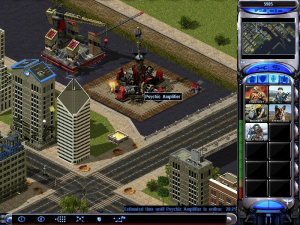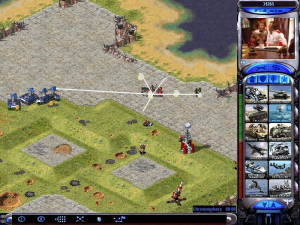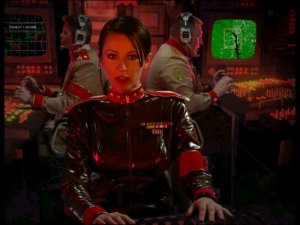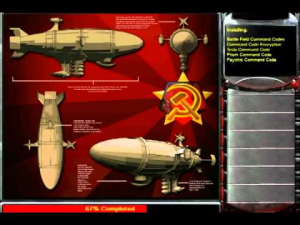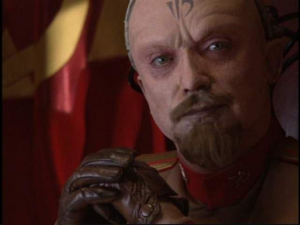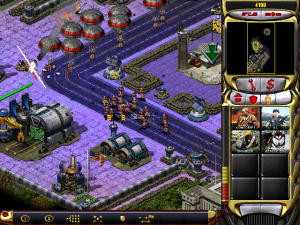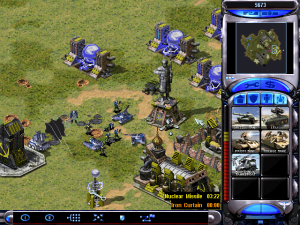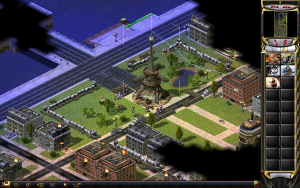- Command and Conquer
- Command and Conquer: Red Alert
- Command and Conquer: Tiberian Sun
- Command and Conquer: Renegade
- Command and Conquer: Red Alert 2
- Command and Conquer Generals
- Command and Conquer 3: Tiberium Wars
- Command and Conquer: Red Alert 3
- Command and Conquer 4: Tiberian Twilight
- Command & Conquer: Generals: Combat Cards
- Command & Conquer 3: Tiberium Wars (Mobile)
- Command & Conquer: Red Alert Mobile
- Command & Conquer: Red Alert (iOS)
- Command & Conquer 4: Tiberian Twilight (Mobile)
- Command & Conquer: Tiberium Alliances
- Red Alert OL
Eleven days before the release of Red Alert: Retaliation in 1998, Westwood Studios, along with sister/subsidiary company Burst Games (AKA, Westwood Pacific) were acquired by EA from Virgin Interactive. This marked a new chapter in the history of those developers and the Command and Conquer franchise. It wasn’t until 2000, however, following the releases of Tiberian Sun and its expansion Firestorm, that a proper sequel to Red Alertwas revealed to the public.
That entry is Command and Conquer: Red Alert 2, released on October 2000. Mainly developed by Westwood Pacific in collaboration by the main branch – the latter at the time busy with various other projects – it built upon the popularity of the first game. Before long, though, it would rival if not usurp its classic predecessor. Not only would it become a classic in its own right, but also become among the most defining titles in RTS and PC gaming at large. This is in part due to how it all but defined the franchise as it’s remembered to this day.
Following the precedent of using “good guy” outcomes as canon, the game takes place in broadly the same timeline as Red Alert 1’s Allied ending, the gist of which is first conveyed through the rather creative installation screen. It’s now 1972. 20 years have passed since the end of World War II and the death of Josef Stalin. On behalf of the Allied Nations, the United States had propped up a man named Alexander Romanov to ultimately lead a seemingly defanged Soviet Union. Beneath the friendly façade and lip service to peace, however, the Premier is revealed to be an avowed Communist and deeply resents what the Allies had done to his beloved Motherland. With the aid of his increasingly trusted adviser – a powerful psychic named Yuri, said to be Stalin’s prodigy – the USSR spends the intervening time rearming and strengthening itself while once more spreading Communism. When it becomes clear that his plans could no longer be kept hidden, he and Yuri orchestrate a full-scale invasion of American soil (complete with a large-scale tank assault from Mexico) and sabotage the US nuclear arsenal, to President Michael Dugan’s utter shock. Thus, begins the Third World War, fought with even more powerful and fantastical weapons, along with far higher stakes than before. All the while Yuri plots behind the scenes, with more ambitious and insidious motives in mind.
The campaign mode further builds upon this curious turn of events over of the course of 24 missions – each faction having 12, not including the two “Boot Camp” training levels or the co-operative missions – and it is here that the changes grow more apparent. You take up the role of either a rising Soviet officer at the spearhead of the invasion of America, or a newly minted field commander tasked with stopping said invasion and taking the fight back to the Commies, the entirely linear storyline quickly diverging for each side. The missions themselves are made even more varied, dynamic (with a number of missions having battlefields expand in scope) and successively challenging, with the myriad objectives, side goals and hidden secrets alone (such as bonus crates, usually found by blowing up certain structures) adding quite a bit of replayability; in addition to helping ease you into the new features and units, as an added touch the after-mission timer and statistics from Red Alert return, now coming with a post-script that changes depending on how you perform. Then there’s the introduction of co-operative missions set amidst the conflict – three for the Allies and two for the Soviets, scattered over several maps – that can be played with a friend through LAN or online; while rather rudimentary, it showcase just what was possible.
At the same time, not only are there significantly more in the way of FMVs and CG cutscenes (close to an hour’s worth of footage), but also a larger cast to accompany them, featuring a number of character actors and B-movie stars. The Allies for instance have a colorful ensemble like US President Dugan (Ray Wise) and Special Agent Tanya Adams (Kari Wuhrer), which the Soviets more than compensate with the likes of Premier Romanov (Nicholas Worth) and the infamous Yuri (Udo Kier) in all his entertainingly villainous stride; this isn’t even getting to Gen. Carville (Barry Corbin) making a return from Retaliation – while channeling even more of WarGames – or your loyal and very personable intel officers, Lt. Eva (Athena Massey) and Lt. Zofia (Aleksandra Kaniak). Aside from the evidently higher budget on display and the rather cinematic flair, these FMVs don’t just continue the then-emergent franchise trend of having recognizable celebrities. But they’re also integrated during gameplay in the form of “incoming transmissions” (a first for the series, though previously introduced in Tiberian Sun) alongside voice-acted scripted moments, all while doing a good job in conveying how you are the main character. But when combined with good writing, memorable performances and setpiece spectacle, they help bring the Red Alert universe to vivid life like never before. Which further adds to the replay value, if only to see the story unfold again and the humorous elephant in the room.
One need only see the opening video that plays when Red Alert 2 (aka, RA2) starts, featuring among others giant squids and the aforementioned land invasion of America, to see the significant, yet consistent shift in direction compared to the first game. For one, in addition to taking inspiration from secret projects and conspiracy theories from the 20th Century, similarly to Red Alert 1 (the inclusion of psychics like Yuri derived from paranormal research conducted by the USSR in real life), the backdrop also takes more than a few cues from Cold War movies and propaganda from both sides. But while the results more than speak for themselves – whether it’s the initial missions being blatant homages to movies like Red Dawn (the first Soviet mission involving an all-out assault on Washington DC), Gen. Carville complaining how there are more cows in Canada than people or the cheesiness underpinning much of the acting – the overall plot is played completely straight, retaining a degree of weight and seriousness to balance out the over-the-top hijinks. This is especially highlighted in the campaign storyline involving the Soviets, taking the trend of humanizing them previously even further. To be sure, they’re still portrayed as the “bad guys” (such as the allusions to the Communist tendency of rendering enemies of the state “nonpersons,” or having little regard for casualties) and have their fair share of infighting (reflected in missions that involve fighting other Soviet enemies). Yet with the exception of the obviously villainous Yuri, they’re noticeably more stereotypical yet relatable compared to their Stalinist incarnation such that you’d want to play as them; eventually, they even go against Yuri once they catch on to his plans. Then there’s the way it drops any clear continuity to the Tiberium timeline, save for a “broad strokes” approach regarding the events of the preceding game and a few franchise nods (like Lt. Eva’s name being a reference to GDI’s EVA interface). Although Westwood, according to former series designer Adam Isgreen in a 2006 thread on Petroglyph’s forums, had plans of reconciling the Tiberian connection by suggesting that the events of RA2 was the result of further tampering with time (among other ideas), it’s all but stated that the setting is its own parallel universe.
These changes extend in-game as well, regarding the factions. The differences between the Allies and Soviets are taken much further than in Red Alert 1 as for the time in the entire franchise (save for a handful of exceptions like Engineers, Attack Dogs and Ore Refineries), they each have their own separate, though equivalent, units, tech trees and structures, complete with very distinct aesthetics; Soviet buildings for instance have a very industrial look to them (with some Socialist Realism and Orthodox touches), while Allied ones wouldn’t be much out of place in the actual 1970s-80s. The various units are likewise substantially overhauled, reflective of both the setting and their sides’ strengths while giving them more versatility. The Soviets’ loss of much of their air force and rearmament in the backstory, for instance, manifest in their reliance on brute force (especially in the form of their naval Dreadnoughts, Mammoth-esque Apocalypse Tanks and the legendary Kirov Airship), expendable mass attacks (such as their use of cheap yet plentiful Conscripts and tank-destroying Terror Drones) and psychic research (including Yuri himself, capable of mind-controlling enemy units from range).
The Allies’ penchant for efficiency and flexibility coupled with an inventive streak is seen through their use of lightly armored yet fast vehicles (such as their basic Grizzly Tanks and Mirage Tanks), having potent air power (through Harrier jets and Nighthawk transport helicopters) and growing use of high-tech weapons (be it their long-range Prism Tanks or Chrono Legionnaires that can literally erase enemies from time), to say nothing of Tanya returning as a commando. It should be stressed as well that even with the Sci-Fi weapons, they don’t go overboard so as to completely overshadow more conventional arms or look too out of place with the alternate Cold War backdrop. Meanwhile, the idea of sub-factions makes a return, though the playable nations (seven in skirmish and multiplayer) now have more tangible bonuses in the form of unique units, structures or abilities; these include France’s Grand Cannon defenses and Korea’s Black Eagle fighter jets for the Allies, as well as Russia’s Tesla Tanks and Iraq’s radiation-spewing Desolator troops. Their respective superweapons have similarly received a makeover. Both the Chronosphere and Iron Curtain in particular are given an upgrade; though both are still harmful to infantry, the former can now permanently teleport more than one unit at a time, while the latter can render a small battalion of tanks invulnerable for limited timeframe. To compensate for America’s loss of missile silos (the Soviets still retaining nuclear weapons), the Allies also have access to the Weather Control Device courtesy of Einstein, capable of weaponizing a massive lightning storm. Thus, you have more in the way of variety and diverse options compared to earlier entries in the Command and Conquer franchise, which would serve as a benchmark for later titles like Generals. Arguably even more impressive is how the developers, for the most part, manage to retain balance through having such powerful arsenals rather than in spite of them.
Then there’s the overall presentation, which not only drives home the aforementioned changes but also helps make the RA2 stand out. For one the game uses a “2.5D” voxel engine – more specifically, a significantly modified and “refined” version of the Tiberian Sun engine – that combines 2D sprites with 3D pixel rendering (particularly for certain vehicles and structures), as well as isometric terrain. This shift from Red Alert 1’s graphics makes it possible (among other improvements) to show different elevations and more vibrant landscapes covering various parts of the worlds (including built-up urban areas), introduce more tangible environmental effects (such as debris from destroyed structures being able to damage nearby units) and allow for more elaborate particle effects (from lasers and Tesla-charged attacks to more cinematic explosions), while also making it easier to organize bases. The higher resolutions and crisp, detailed art style also make it easier to distinguish figures on the battlefield, let alone tell apart friend from foe without sacrificing a sense of scale especially on larger maps; that the game scales well even on modern monitors (typing “hires” on the menu screen unlocking more display options) helps as well.
Meanwhile, more attention is put in the voice acting, as not only does each faction have appropriate if stereotypical accents for the units, (aside from certain vehicles recycling the same tracks) they also have their own distinct responses, complete with cheesy one-liners; infantry units even have special lines (usually sounding panicked or calling for backup) when they’re under fire. All these are complemented by good audio design and a metal/techno soundtrack by Frank Klepacki that’s at once ominous and pulse-pounding, which includes the second (and perhaps most popular) iteration of “Hell March” as the game’s theme song. It still speaks volumes how close to two decades since release, the sights and sounds still remain impressive many years on.
This extends as well to RA2’s gameplay by codifying and popularizing aspects of the Command and Conquer formula, as it’s known today. For the first time in the franchise, for example, the game introduces the ability for troops to garrison structures (like bunkers and civilian buildings) to significantly increase their effectiveness so long as said structures remain standing; while at this point only basic infantry such as Soviet Conscripts can enter buildings, garrisoned units especially in large numbers can do a good job holding down strategic sections of the battlefield. RA2 also toys around with having some units come with some secondary ability, such as Allied IFVs switching weapons depending on the unit stationed inside (with Engineers turning them into repair vehicles) and GIs capable of hunkering down with heavy MGs, or Soviet Psi-Corps Troopers being able to unleash a psychic blast and Tesla Troopers being able to supercharge any nearby Tesla Coils.
Meanwhile, the espionage elements from Red Alert make a return, only now it’s also possible to access stolen tech units (like the Chrono Ivan for the Soviets) by infiltrating certain enemy buildings. At the same time, the game improves upon elements that were introduced in Tiberian Sun. These include the concept of veterancy – wherein units accumulate combat experience, gaining more buffs (from stronger attacks and longer range to self-healing) as they get promoted into veterans and eventually, elites – and the presence of neutral tech structures scattered across the battlefield (such as oil derricks and airfields) that can be captured for extra resources and support powers. With the faction dynamics and new possibilities offered in terms of strategy, these all blend rather well with the tight, intense action seen previously, while streamlining the rest (such as removing the need for ore silos and having dedicated build queries for main and support structures); the interface is also fine tuned further to lessen the learning curve and reduce the need for unnecessary micromanagement. This isn’t even getting to online patch support, the AI (particularly in skirmish) being improved considerably and putting up more of a challenge in higher difficulties, or the diverse maps and various offline and online multiplayer options offered (including random map selection and custom modes like infantry-only bouts). Sufficed to say, the entertainment to be had is all but timeless, holding remarkably well long after release.
For all RA2 does right, however, it’s not without a few blemishes, a number of them emerging with the passing of time. Whichever copy of the game you may have, compatibility issues with modern systems such as those running Windows 10 have grown more evident; though not as bad its predecessor, it still usually requires finding workarounds and makeshift solutions online to get it running properly. The shift in tone may also dissuade those who prefer the more serious, realistic atmosphere in either Red Alert or the Tiberium games. Meanwhile, some of the imagery of familiar locales being under attack – whether it’s the destruction of the Statue of Liberty during the Allied campaign or the Soviets turning the Eiffel Tower into a giant Tesla Coil to subjugate Paris – may come off as politically irreverent (if not seemingly offensive for certain people) in the wake of 9/11; while by no means any fault of the game or its developers, it nonetheless explains why the original ads and cover art, which infamously included among other things the World Trade Center amidst explosions, were hastily changed.
In the end though, such issues are miniscule compared to what had been achieved. It’s not for nothing that RA2 is seen as an example of a sequel that not simply manages to be as good as the original, but in a sense surpasses it. The game helped make the Red Alert series, along with Command and Conquer as a whole popular even beyond the RTS genre, topping PC Data’s top-selling games list for November 2000 alone and receiving the “Platinum” Sales Award from the UK’s Entertainment and Leisure Software Publishers Association; it’s no easy feat, given the growing competition from other RTS works like Starcraft and Age of Empires. PC Gamer named it the “best real-time strategy game and the best multiplayer game of 2000” for its seventh annual awards in 2001, mirroring similar accolades from other publications and among gamers; with its mix of Cold War carnage and campiness, balanced multiplayer, bombastic action and simply being fun to play, it’s not a stretch of the imagination to see why many found the praise earned. Its influence on later titles in the franchise could not be understated, many of its features such as garrisoning and veterancy becoming mainstays. As well as its impact on the fandom and online communities that emerged around it and the series, which would have long term consequences down the line.
The developers, though, didn’t rest on their laurels. As about a year following the game’s release, its expansion pack came out with similar applause.
Command and Conquer: Yuri’s Revenge
With the success of Red Alert 2, the odds of an expansion pack coming out were all but inevitable, the Soviet ending even goes so far as to feature a cliffhanger foreshadowing it. True enough, an announcement from Westwood Pacific on April 2001 revealed just that. That being Command and Conquer: Yuri’s Revenge, which was released on October 2001, its original September launch cancelled due to 9/11. Even with such circumstances in mind, expectations were unsurprisingly high. But not only did it meet said expectations for the most part, but it would further improve upon what had already worked.
The story takes over from where RA2’s Allied ending left off. World War III is finally over, but just when peace in our time was imminent, the villainous psychic Yuri resurfaces. Not only is it revealed that he along with his followers, having gone rogue from the defeated Soviet Union, had formed a private army while the Allies were resting on their laurels. But in an ultimatum he personally gives to US President Dugan and his staff, he also had powerful Psychic Dominators built in secret, strong enough to turn just about everyone on Earth into mindless slaves to the megalomaniac’s will. The Americans manage to cripple the one built on Alcatraz Island off San Francisco, only to find out too late that the other devices had been activated, much of the world already lost. And so, the remaining Allied remnants race to find a way to undo what Einstein dubs the Psychic Dominator Disaster before they too are mind-controlled, which involves a modified Chronosphere to go back to the start of the conflict. Meanwhile, Soviet holdouts loyal to the deposed Premier Romanov learn of the time travel scheme and plot to seize the moment, both in the name of punishing the “Traitor Yuri” and winning the war.
The campaign further elaborates on the plot, though goes a tad bit further. Covering 14 missions – seven for the two factions, not counting the 10 co-operative missions (three for each, with two “Alliance” maps) – you play as either the same Allied or Soviet protagonist from the main game as you try to help set things right, one way or another. The storylines, which span even more of the world and beyond, not only diverge nigh immediately (the Soviet one in particular involves both changing the course of World War III and stopping Yuri), but also make the most out of running with the premise in different ways. This can be seen in the missions themselves, as on top of being generally lengthier and harder affairs, they’re even more varied than in the base game and have more scripting to add more spectacle and little touches (such as losing a certain special unit only to encounter him again back in time), adding further replayability to such a linear tale. The additional co-operative missions, meanwhile, further add new challenges while proving the idea that LAN and online co-op is doable. Then there’s the execution of the cinematic aspects, the vast majority of the main game’s cast, from Yuri himself and Premier Romanov to Tanya (though now with blonde hair) and Gen. Carville making a return for the cutscenes (with about an hour’s worth of FMV and CG footage) with their respective actors hamming it up on-screen all the more. Put together, these drive home how much the setting – taking more than a few cues from conspiracy theories, Cold War propaganda and Sci-Fi pulps – ramps up the audaciousness of it all; to a name a few, an Allied mission has you stopping a plot by Yuri to mind-control Americans through Hollywood (complete with cheesy if sly jabs at the media), while a Soviet mission even has you leading a Lunar expedition, complete with appropriate mechanics (like reduced gravity and Cosmonaut infantry) which never again appear in the Command and Conquer franchise. Yet even at its wackiest (the time-travel hijinks being the just the icing) the story remains solidly delivered and retains a serious weight where it counts, all the while being entertaining to just watch; sure, the Soviets taking a detour to the Cretaceous by accidentally overcharging the Chronosphere and holding off dinosaurs is ludicrous, but the character development of Romanov as he shows how friendly he truly is without Yuri’s influence is worth watching. Sufficed to say, while seemingly far removed from the original Tiberian timeline it makes for a memorable experience.
Among the new additions in Yuri’s Revenge (aka, YR) is making the titular villain’s personal army playable for skirmish and multiplayer. While founded by the man himself and his followers, Yuri’s Forces aren’t a simple reskin of the Soviets but rather a full-blown faction in its own right; dropping the Communist veneer, their overall aesthetic can be described as “Bond villain”-esque with vestiges of its Slavic, Eastern European origins in some of the more industrial elements. On top of having carried over the former Psi-Corps and the technologies Yuri conceived (such as Clone Vats and Psychic Beacons), they have access to an exotic arsenal that emphasizes speed and flexibility to a much greater degree than the Allies. While some of their units are relatively conventional (such as multi-role Boomer Submarines and Gatling Tanks that increase damage the more they’re active), many range from the esoteric (basic Initiates able to burn enemies with augmented pyrokinesis) to cruel (having Slave Miners as mobile ore refineries and horribly mutated Brutes as melee tank hunters) to ludicrous (the latter including Masterminds being brains on treads and UFO-style Floating Disks). That’s not even getting to Bio-Reactors which can generate more power by “garrisoning” infantry, Grinders capable of breaking down anything (even people) into raw resources, defenses than can mind-control units or the Psychic Dominator itself being their superweapon (able to destroy whole swaths of land and permanently mind-control the survivors through Yuri’s psionic energy). While their nigh gimmicky and over-the-top nature make them very difficult to play as, in the right hands they can be overwhelming if not outright overpowered; it’s no wonder why they’re often banned in online matches and tournaments. And while there’s no campaign route to speak off for Yuri himself or his faction (outside of three co-op missions), that they’re undoubtedly fun to wreak havoc with is more than a consolation.
These aren’t to say that the other factions are left out. The Allies, for instance gain access to a host of curious weapons into their arsenal. From rocket launcher-equipped Guardian GIs and Robot Tanks immune to mind-control to the lumbering Battle Fortress (part-APC, part moving bunker than can crush other vehicles), there’s much more in the way of versatility this time around. As for the Soviets, to compensate for the loss Yuri and his tech, they instead resort to more conventional means to bolster their firepower. This results in them having regaining some air power (through Siege Gunships that double as artillery platforms when grounded), a new commando unit on par with Tanya named Boris (who can also call in MiG fighter airstrikes from a distance) and more emphasis on mass production and defenses (through Industrial Plants and Battle Bunkers), which combined with their existing weaponry can still make them potent on the battlefield. When combined with tweaking and the inclusion of Yuri’s Forces, these additions provide more complicated and flexible dynamics for all factions, while opening up new strategies compared to the main game.
Gameplay and presentation wise, YR manages to successfully build even more on what worked in RA2. Arguably, as much as the main game did in refining and polishing the classic Command and Conquer formula, the expansion brings it rather close to perfection. The idea of neutral tech buildings is further expanded upon with the addition of capturable hospitals (which auto-heal infantry), machine shops (doing likewise for vehicular units), civilian power plants and secret labs (the latter giving access to units belonging to a certain faction or country) that can give you or your enemies an advantage. Support powers also play more decisive roles compared to RA2, whether it’s in opening up hidden parts of map (like the Soviet Spy Plane) or turning enemy infantry in a target area into Brutes (as with Yuri’s Genetic Mutator). Meanwhile, though a smaller point compared to the others, everything now has a unique voice track befitting themselves and their respective side instead of having some units recycle the same lines; this in turn marks a culmination of the trend of divergent factions going back to Red Alert 1 while setting a benchmark for others to follow. When combined with an intense soundtrack by Frank Klepacki, new maps, extra multiplayer modes and fine tuning through online patches, these not only improve the already excellent action, but help push it further. Whether it’s simple skirmish match or a large multiplayer brawl, it’s an utter thrill to play.
Close to perfection, however, doesn’t mean that it has no evident flaws. Much like the main game, YR has its fair share of compatibility problems with modern systems. In addition, balancing issues especially for multiplayer are considerably more pronounced this time around and even remain a point of contention. On top of Yuri’s Forces being overpowered, the tweaks and patches have also rendered the Soviets weaker in competitive play while making Allied players more dominant meta-wise. A consequence of this is that while the game has a lot of longevity, it can get more complacent after a while. As an aside, it also marks the last time creative installation screens are included in Command and Conquer.
Nonetheless, such issues pale compared to the whole package. YR received very positive reviews from the press, even winning PC Gamer’s “Best Expansion Pack” for 2001 (alongside Baldur’s Gate II: Throne of Bhaal) during that magazine’s eighth annual awards. Among gamers, both long-time fans and newcomers alike, it helped in a sense in immortalizing the Red Alert series and Command and Conquer as a whole. To this day, it remains among the most popularly played in the franchise; this is especially true online, with modern, fan-run multiplayer suites like CnCNet taking the place of the long-defunct servers. Indeed, it could be said with confidence that it’s not for nothing that many tend to see it and RA2 as legendary, the epitome of Westwood’s classic design.
Which is perhaps as fitting a way to go for the developers as any, given the circumstances. For while RA2 and YR weren’t the last Command and Conquer works to be made by them, they nonetheless signify the last main entries in the series under Westwood’s name. By January 2003, EA closed down Westwood Studios for good (though not before releasing one more map pack for the game). What remained, including Westwood Pacific, was soon reborn as EA Los Angeles, and the rest is history. The legacy of Red Alert, however, wouldn’t stay dormant for long.
Fan Showcase: Mental Omega APYR
Close to two decades have come and gone since the release of Red Alert 2. The game has long outlasted the studio that developed it, but not the loyal fans it and Yuri’s Revenge had earned over the years. As commendable as its staying power or the vibrant online communities supporting it alone can be – the fact that multiplayer is entirely fan-run at this point is a feat for an old game that hasn’t yet become freeware – just as impressive are the game mods that said communities have spawned. Indeed, enough time has passed that not only have there been a multitude of fanworks online, but some programmers have gone so far as to create an open-source DLL extension for YR named ARES by 2010 to extend what the game engine’s capable of. Among the most famous and well-received of these projects is Mental Omega: Almost Perfect Yuri’s Revenge.
Commonly known as either Mental Omega APYR or simply Mental Omega (currently at “Version 3.3.3” as of 2018), it is a fan-made expansion pack by the Mentalmeisters team, led by original modders Speeder and Mevitar. From its origins as a balance mod in 2005, it saw several changes in direction and scale, most notably during the transition from “2.0” (which tried to continue the plot of the original game) to “3.0” in 2013. At its present form, the mod overhauls just about everything to enhance the Red Alert experience, all the while seeking to keep true in spirit to it. The results, though rival professional developers in effort.
For one, the mod uses the opportunity to take the plot of RA2 to uncharted waters and then some. Seemingly taking a few cues from Tiberium Wars, there’s a lengthy campaign spanning two main acts, an “Origins” arc and “Covert Ops” side-stories with a total of 75 missions (the large majority of which already playable). Encompassing various factions along with some significant world-building, it reimagines the setting to be more serious ala Red Alert 1 or the Tiberium timeline, though with dark humor in place of the campiness, and with the bombastic spectacle still intact. While the plot starts of similar enough to canon and familiar hijinks still ensue, it doesn’t take too long before events start going off the rails, be it President Dugan dying within the first few missions or the Soviet invasion of America succeeding by the end of “Act 1.” Coupled with new, interesting characters – from Siegfried, Einstein’s successor and CEO of SteinsTech to a Chinese prodigy named Yunru, who plays a much larger role than her youth lets on – and giving Yuri more motives and goals beyond his canon villainy, the ensuing plot (told through in-game cutscenes and text for the most part) is rife with many interesting twists that are rather original while also harkening to various events throughout the Command and Conquer saga. That the missions themselves tend to be long, challenging yet entertaining romps and vary significantly (from classic base-building affairs to gimmicky covert affairs) depending on the faction helps as well, as do the many co-operative missions adding more in the way of difficulty; with the save/load function restored in the latest rendition, said missions are now even more accessible.
Compared to canon, there are four factions at play. The Allies and Soviets superficially retain many aspects of their canon forms, including the most basic units. These however betray how much they’ve been reworked from the ground up, with Mental Omega ramping up the sub-factions (three for each) to the point of them being reminiscent of Zero Hour or Kane’s Wrath in terms of variety, with different strengths, units and structures; the Soviet-aligned Latin Confederation, for instance, has access to flame-based weaponry and the Catastrophe Tank (a stripped-down though still potent copy of the Apocalypse Tank), while the Allied Pacific Front utilizes an arsenal filled with long-range weapons and experimental tech such as Tsurugi Powersuits and robotic Hunter-Seeker kamikaze drones. Meanwhile, Yuri’s Forces (renamed the Epsilon Army) are given even more of an overhaul, with their own sub-factions, a plethora of new units and tweaks away the overpowered aspects while retaining their very unconventional doctrines; Scorpion Cell in particular emphasizes their penchant for hit-and-run and subversive tactics while Epsilon HQ puts more focus on territorial control and genetic manipulation through Stalkers (enhanced Brutes) and the Aerial Fortress Irkalla. Then, there’s the fourth side, the Foehn Revolt. This entirely new faction, which comes off like a mix between an underground resistance and an even more futuristic take on GDI, places emphasis on nanotechnology, expensive yet highly advanced weapons and the power of small groups if not individual units; these can be seen from their common Knightframes being able to deal with other enemy infantry to the Wings of Coronia’s ability to call in a deadly Harbinger Gunship to turning the wind itself into a base-destroying Great Tempest. Add in powerful commando/hero units and support powers unique to each sub-faction, consistent art direction and a serious attempt at balancing, and you have a well-rounded roster about as fun to play as that of the original RA2.
This is not to downplay the substantial effort put on the overall presentation. Utilizing ARES, Mental Omega pushes the game engine is further than what Westwood originally intended, whether it’s in the enhanced animations and effects or how it makes some of the new mechanics (such as the Foehn’s Nanofiber Sync) possible. The soundtrack, meanwhile, is comprised of several tunes that are thematically grouped per faction ala Generals (the Allied and Soviet ones using Frank Klepacki’s music and even remixes of classic tracks) and along with new voice acting for each faction (which blend in nicely with the ones carried over from RA2 and YR) complement even more with the intense action. Then there the multitude of nods to the Red Alert series and the wider franchise sprinkled about, which go beyond having units inspired by concept art and dummied out content that never made to the final product (such as the Centurion Siege Crawler for Soviet-aligned China). Whether it’s the USA’s Athena Cannon being based on a similar unit from Red Alert 3, an upgraded Volkov making his return from Red Alert 1 as a Russian commando, Epsilon’s Scorpion Cell being reminiscent of the GLA from Generals (with Nod’s emblem to boot) or a Soviet campaign mission set on the Moon (with the exact same mechanics as in YR) to name a few, the modders show a clear fondness for the source material while still managing to deliver something original. Which isn’t getting to the gameplay itself (combining classic C&C with modern touches), or how the mod comes with its own launcher and built-in multiplayer through CnCNet with all that entails. All in all, it’s a feat that rivals even professional work.
Mental Omega is not alone, however, in being a showcase of how far fans will go to honor a classic saga. Various mods exist of high caliber, such as Red Resurrection (a similar reimagining of the source material), D-day (a total conversion based on the actual World War II) and the recently released Tiberium Crisis (which recreates Tiberium Wars and whatever could be salvaged from Tiberian Twilight); that such works increasingly utilize ARES and CnCNet integration further help in popularizing these further online.
With all the above put into account, it’s not a secret how to this day you’d likely find people playing RA2 and YR, modded or otherwise; about half of the over 1,000 users on CnCNet at one point on June 2018 were reported as playing Mental Omega, according to CNCNZ. Let alone how the last Command and Conquer entries made under Westwood’s name continue to remain among the most popular and enticing in the franchise.
